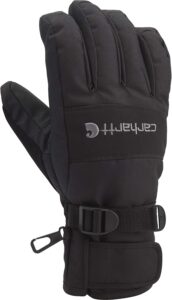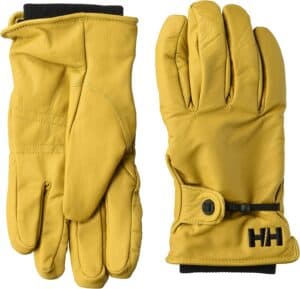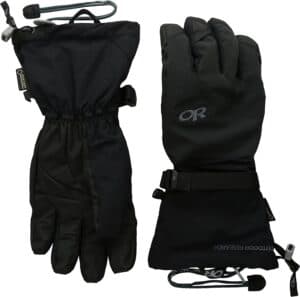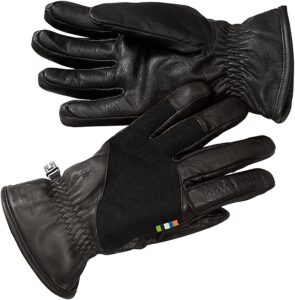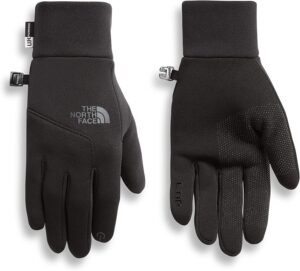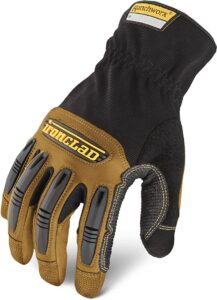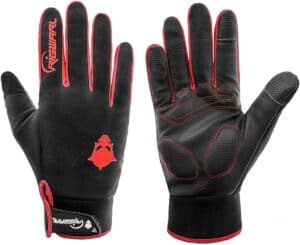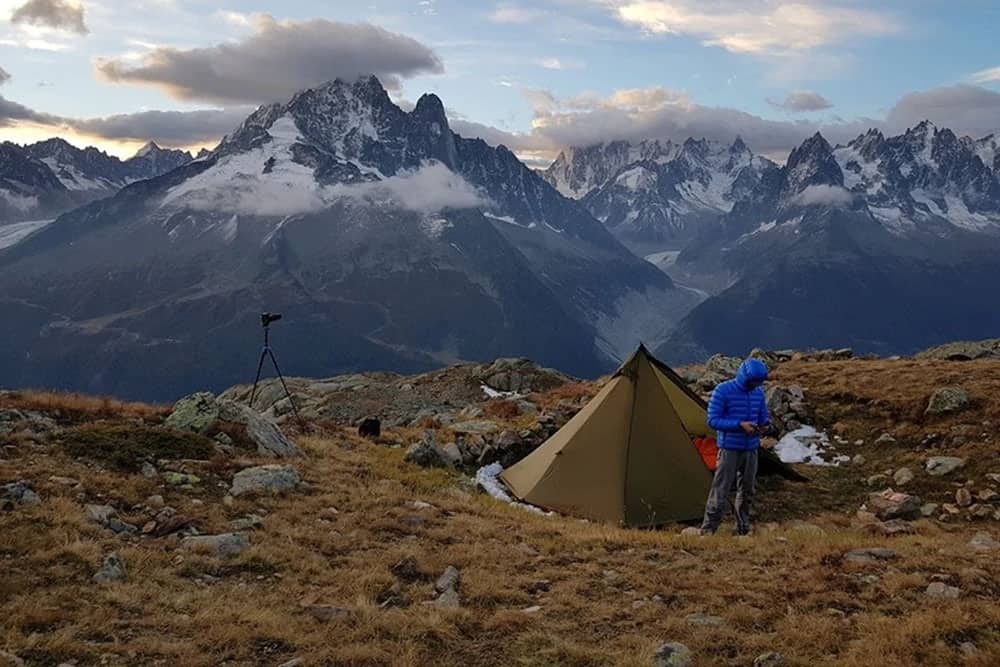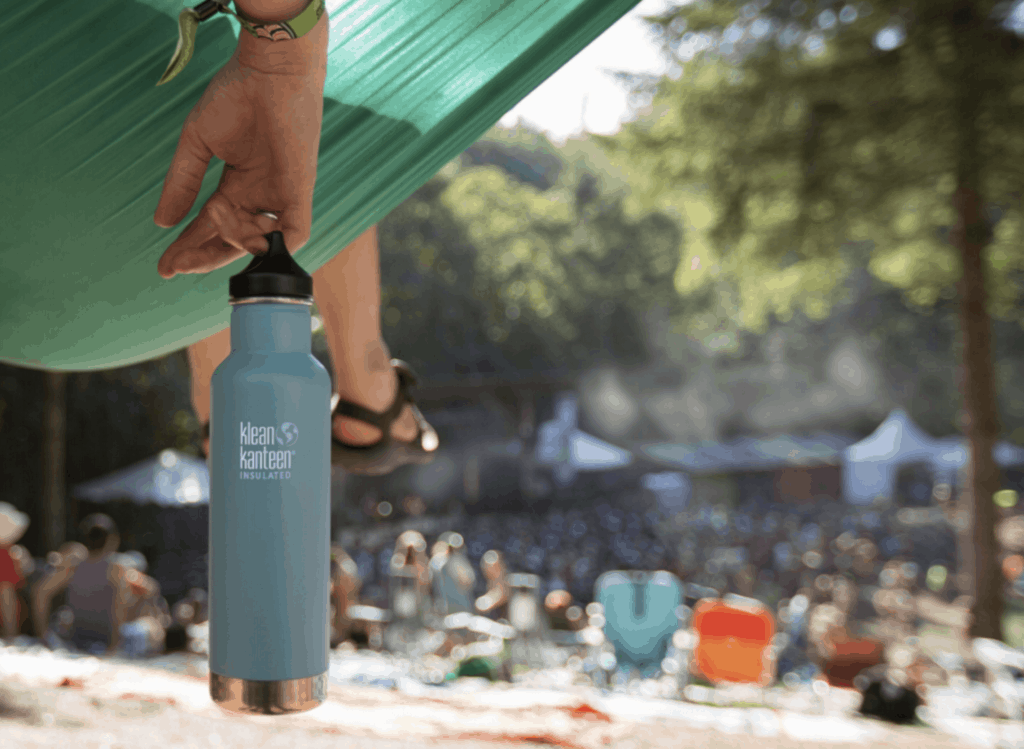Cold hands are sure to derail even the brightest of winter days. If you plan to spend a lot of time outside this winter, you’re going to need a quality pair of winter gloves to bring along. Whether you’re an avid backcountry skier or you prefer the winter season for your hunting expeditions, keeping your hands warm and healthy is critical to a winter season well spent.
Our list of the 9 Best Winter Gloves will give you plenty of options to keep your hands warm and dry this winter. Also, be sure to check out our Buyer’s Guide section for all the critical factors to consider when choosing new winter gloves.
1. Carhartt WB
The Carhartt WV winter gloves are designed to keep the most important tools of all protected against the winter elements. Your hands will love the ultra-soft insulation and Fast Dry technology that wicks away sweat when work heats up.
These winter gloves are made of 100% polyester. The shell is a durable, all-purpose polytex with softshell trim and a reinforced PU (3) palm. These gloves boast Storm Defender waterproof breathable protection and a windproof insert to keep your hands warm and dry in even the wettest of work conditions.
2. Dakine Nova
These Dakine Nova short winter gloves are designed with a DK Dry waterproof insert and a combination nylon/polyester shell that’s finished with a durable water repellent (DWR) treatment. They are a great glove for a variety of winter activities, such as backcountry skiing and snowboarding, snowshoeing, and more.
These winter gloves boast high-loft synthetic insulation and a 150-gram tricot (1) lining. The palm is also made of durable water repellent leather, so your hands stay warm and dry in even the wettest of winter weather.
3. Helly Hansen VOR
With shell and palm composed entirely of Grade A goatskin leather, the Helly Hansen VOR winter gloves offer a classic work glove design with a rodeo styling. They are an excellent choice for all winter experiences from work to fun.
These gloves have sock cuffs with cinch straps to keep them secure throughout your day. The goatskin used in these gloves is water repellent and they include an anti-pilling micro fleece to keep your hands warm, dry, and comfortable.
4. Hestra CZone Contact
The Hestra CZone Contact is a true multi-purpose outdoor glove made for cold weather and unexpected weather changes. The glove’s Contact-membrane makes them waterproof and breathable while maintaining a precise, close grip.
These winter gloves are made of Hestra flexon 4-way stretch synthetic material. This material is windproof, waterproof, and highly breathable for warmth and comfort. Additionally, these gloves boast a reinforced palm and a silicon grip print for increased functionality.
5. Outdoor Research Alti
This expedition glove has improved ergonomics and dexterity as a product of Outdoor Research’s revolutionary 3Dfit technology (2). With added PrimaLoft® hi insulation in the shell, these gloves also offer added warmth for all your favorite winter activities.
The Outdoor Research Alti winter gloves are made of a combination of 90% nylon and 10% spandex. They are waterproof, breathable, and windproof gloves that also feature an upgraded liner for better moisture management. These gloves also come with an Alpen grip palm.
6. Smartwool Ridgeway
These multi-purpose leather gloves boast a double layered thumb and forefinger for added reinforcement while shoveling or when gripping ski poles. These gloves will serve all your needs through anything a long winter season throws at them.
The Smartwool Ridgeway winter gloves boast a terry loop knit interior lining to increase warmth and add comfort. The exterior of these gloves is 100% leather while the interior is 70% wool and 30% nylon. In addition, these winter gloves feature the high-quality Merino wool that the Smartwool brand is known for.
7. North Face Denali Etip
These are the ultimate UIR powered soft-shell winter gloves. They’ll keep your hands warm while still allowing ample functionality, including in the operation of all your touchscreen devices. These gloves also take care of your hands using radiometric articulation, which keeps your hands in their most natural, relaxed position.
The North Face Denali Etip winter gloves feature a silicone gripper palm that provides superior grip in cold, wet conditions. The soft shell on the back of these gloves blocks wind and moisture and keeps your hands warm and dry. These gloves are made from 93% polyester material and 7% elastane double-knit fleece that features four-way stretch capability. Finally, North Face’s 5-dimensional fit ensures consistent sizing across a wide variety of hand types.
8. Ironclad Ranchworx
The Ironclad Ranchworx winter gloves have to be included in any conversation about the best winter gloves for work purposes. These gloves are made entirely of machine-washable, genuine Bullwhip leather that won’t dry out or shrink when wet. To protect your hands, these gloves include Kevlar reinforcements in critical areas for maximum durability.
These winter gloves also feature patented roll tip fingertips that provide double-layer protection while ensuring improved dexterity. Added Exo-Guard protection keeps your knuckles safe from scrapes and cuts while the added terry cloth sweat wipe on the back of the thumb helps you wipe sweat from your brow even when it’s cold enough to see your breath.
9. Rigwarl Cold Weather
These winter gloves are the four-season motorcyclist’s dream. They are made of reinforced leather to protect your fingers and their water-resistant shell makes them both windproof and waterproof. An improved fleece liner also keeps your hands warm even if you’re riding through snow and rain.
The Rigwarl Cold Weather winter gloves are designed with touchscreen-compatible fingers so that you can make calls or update your GPS without exposing your hands to the elements. They also feature a reinforced leather grip palm to protect your hands as they grip your bike to steer through cold winter weather.
—
Buyer’s Guide
The history of gloves is an interesting one and dates back as far as 1,400 years B.C., to a pair of linen gloves found in the tomb of King Tutankhamen. The word ‘glove’ is closely related to the Old Norse word ‘glofi’, which could suggest that gloves were utilized by the Viking warriors of early Scandinavia. (4) Interestingly, leather has most likely been a common material used in the making of gloves for thousands of years.
Today’s materials are much more sophisticated and suited to precise conditions. But with the invention of improved materials and the subsequent explosion in glove options, there are a few critical elements that separate quality winter gloves from their more ‘run-of-the-mill’ counterparts. To aid in your selection, this Buyer’s Guide will focus on these elements.
Sizing
Getting the right size glove is imperative to maximizing its effectiveness. A glove that’s too big won’t hold in as much heat and, therefore, won’t keep your hands as warm as they should. A glove that’s too small, well, we all know that just won’t do.
When considering the sizing options of your top glove selections, the two major measurements you’ll have to consider are hand width and hand length. Hand width is a measurement of the full circumference of your hand around the widest part of your knuckles, but not including your thumb. Hand length is measured from the tip of the middle finger straight down to the large crease where your palm meets your wrist.
These two measurements will be the most effective at helping you choose from the small, medium, large, etc. sizes offered by the top gloves you’re considering. If you fall somewhat between sizes, keep in mind that tighter is generally always better. As we mentioned above, extra space inside your gloves will lead to added heat loss.
That said, you don’t want to buy a glove that’s so small you end up straining the material. This will not only be uncomfortable, but it will also greatly increase the stress on the glove’s seams and, over time, it will be more likely to rip or tear. You’ll also want a glove that’s long enough to tuck completely into your coat sleeves so that you keep your wrists warm.
Insulation
Before we get into the different types of insulation, it’s important to understand how different body types have different needs. On average, men generate more heat than women. This is generally true for people in their 20s to 40s versus folks over fifty. This is important to your glove choice because choosing a glove that has too much insulation can lead to excessive sweating, which is just as risky as having gloves with improper insulation. Considering your gender, age, average activity level, and basal metabolic rate (BMR) (5) will help you make a better glove choice in the long run.
Now, let’s move on to the different types of insulation most common in winter gloves. They are down insulation and synthetic insulation. Down is an excellent insulator that is highly valued for its light weight, its durability and breathability, and its ability to be easily compressed. Although down is generally more expensive than synthetic insulation, it tends to last longer and hold it value over that time.
Down does require protection from the elements by an outer, waterproof shell, which makes it a great choice for gloves that will be used for activities like skiing and snowboarding, primarily in cold, dry climates.
In addition to being cheaper than down, synthetic insulation retain its ability to insulate when wet and also dries much faster than down. This makes it the ideal choice for winter activities that take place in predominantly damp climates. The drawbacks of synthetic insulation are: less warmth for its weight, increased bulk, and a reduction in insulation power each time it is compressed. That said, the most common gloves used for downhill and cross-country skiing utilize synthetic insulation.
When you begin to look into these winter gloves, you’ll find that there is a lot of proprietary synthetics used to insulate gloves from different brands. The one thing that you should keep in mind is that you should never buy a winter glove that relies solely on cotton as an insulating material. When cotton gets wet, it stays wet, and it also stays cold. Avoiding cotton will help you choose a better quality insulator for your winter gloves.
Finally, when you dig into insulation for winter gloves, you’ll find that it is usually measured in grams. This will lead to the question of how much “weight” is recommended for different environments. If you’ll primarily be using your gloves in temperatures at or above 20° Fahrenheit, it’s recommended to have gloves with 80 to 100 grams of insulation.
If you’ll be spending your winter outside in temperatures below 20° Fahrenheit, look for gloves with 100 to 200 grams of insulation. Finally, for your Arctic adventures, search for winter gloves with 200 to 400 grams of insulation.
Waterproofing
The intent of waterproofing winter gloves is to prevent exterior moisture from entering the glove while still allowing water vapor from sweat to vent properly. This is a tricky balance, which is why it’s hard to find a truly 100% waterproof glove that will keep your hands completely dry in even the wettest, coldest conditions. The key is having gloves that will still keep your hands warm even if they do get wet.
In general, there are three ways that glove manufacturers attempt to add waterproofing to their winter gloves. The first is by including a waterproof membrane that is laminated to the exterior fabric of the glove. The second is by placing a waterproof insert between the glove’s outer shell and its interior insulation. The last is by applying a waterproof coating to the glove’s exterior fabric.
One of the most popular waterproofing technologies out there is known as Gore-Tex®. Many glove makers have emulated Gore-Tex using their own proprietary technologies. When choosing winter gloves, take some time to research these proprietary technologies a bit further to ensure that the gloves you choose have the best shot at keeping your hands dry. Dry hands are much more likely to remain warm.
Touch-Screen Compatibility
Winter adventures produce some of the most epic and breathtaking scenery. When you’re standing at the top of a ski run and you want to snap a quick photo before carving turns, taking your gloves off to do so is the last thing you want. That’s why choosing gloves with touch-screen compatibility is a great consideration if winter photography is your priority.
If you need something with a little more weight and insulation than you can find in gloves with touch-screen compatibility, you can also consider buying glove liners that allow touch-screen operation. This way you can slip your heavy gloves off and operate your devices without completely exposing your hands to the elements.
Some Added Bonuses
In addition to the critical elements mentioned above, there are a number of additional features that add value to a good pair of winter gloves. Leather palms, for example, are essential if you’ll be using your gloves primarily for work purposes. Leather provides excellent grip and is also much more durable than common synthetics
Wrist cinches can also be an essential inclusion if you plan on using your winter gloves for skiing or snowboarding. There’s nothing worse than dropping your brand new pair of gloves off the ski lift and these cinches will help you keep your gloves ‘handy’ while you shuffle your iPod or check your phone.
In addition, many winter gloves offer a softer material on the thumb. This area is designed to help you clean glasses, goggles, or simply wipe your nose when the cold is really getting to you. This is a great way to keep glasses, goggles, or your face clean without carrying around a handkerchief all winter.
Lastly, some gloves come with zippered pockets that are typically located on the back of the hand. These pockets serve as a place to fit disposable hand warmer packets on the coldest of days. As an added benefit, they also serve as added ventilation during your warmer spring skiing days.
Frequently Asked Questions
The need for a quality pair of winter gloves is undeniable. If you still have questions about selecting the best pair of gloves to suit your needs, however, this section will attempt to answer some of the more common concerns about winter gloves.
What are the pros/cons of mittens versus gloves?
The main benefit of mittens is that they can actually keep your hands warmer than gloves. By keeping your fingers together in one ‘compartment’ instead of separating them by fabric, mittens help your hands retain heat better than gloves.
The downside, however, is that mittens come with severely restricted dexterity. This is why their use is typically restricted to skiing and snowboarding. If you need to do anything precise with your hands during the winter, mittens probably aren’t the best choice.
What about heated gloves?
Heated gloves typically feature battery-powered heating systems to provide added warmth on the coldest days. Some have different levels of heat output, but most run on rechargeable lithium-ion batteries. While they can keep your hands warmer, the batteries and heating technology make them heavier, bulkier, and much more expensive ($200+) than their non-heated counterparts. Another drawback is that you can’t use these gloves in even the slightest of rains without risking damage to the technological components.
Why goatskin leather versus cowhide?
For starters, goatskin leather is stronger and more durable than cowhide. It is also naturally water-resistant. Finally, goatskin leather is softer and lighter than cowhide, making it an ideal material for comfortable winter gloves.
Are all winter gloves machine-washable?
Generally, you should consult the manufacturer’s recommendation before washing your winter gloves in a machine. Washing them improperly can cause a significant decrease in their waterproof ability. A good rule of thumb is to hand wash any winter gloves that don’t specifically state they are ‘machine-washable’. If they do say they can be washed in the machine, however, it is still recommended to wash them on a delicate or low setting, and in cold water.
What’s the best way to dry my winter gloves?
Like the best washing technique, this will ultimately depend on the manufacturer’s recommendation. In general, though, it is advised to avoid putting your winter gloves through the dryer. The best way to dry them is simply by laying them out our hanging them by the fire, just not too close.
Can you waterproof your own gloves?
Yes, and the best way to do so is to purchase a waterproofing wax or spray. After your gloves are thoroughly cleaned and dried, applying the waterproofing solution evenly over the entire surface of the gloves. Apply extra attention to the seams and stitching, as these are your gloves most vulnerable areas.
Next, allow your gloves to sit for around five minutes before wiping away any excess waterproofing solution with a damp cloth. Let the gloves air dry completely or tumble dry them on low if you wish to speed up the process. Finally, give them a good test by challenging the neighborhood to a snowball fight or snowman-building contest.
Summary
Cold hands can ruin even the best of powder skiing days, even if the rest of your body is perfectly comfortable. We hope you’ve enjoyed this selection of the best winter gloves and wish you the best of luck in selecting a pair that’ll keep your hands warm and comfortable all winter long.
